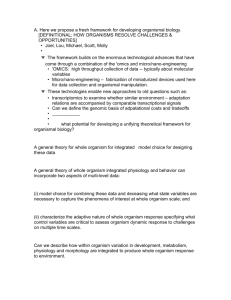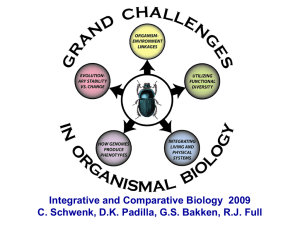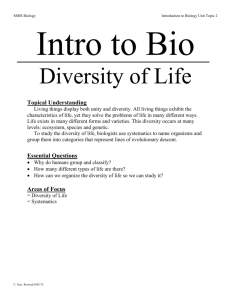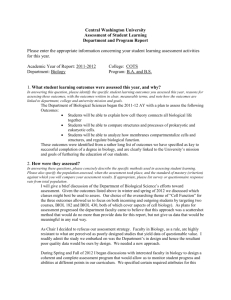1 - iPlant Pods
advertisement
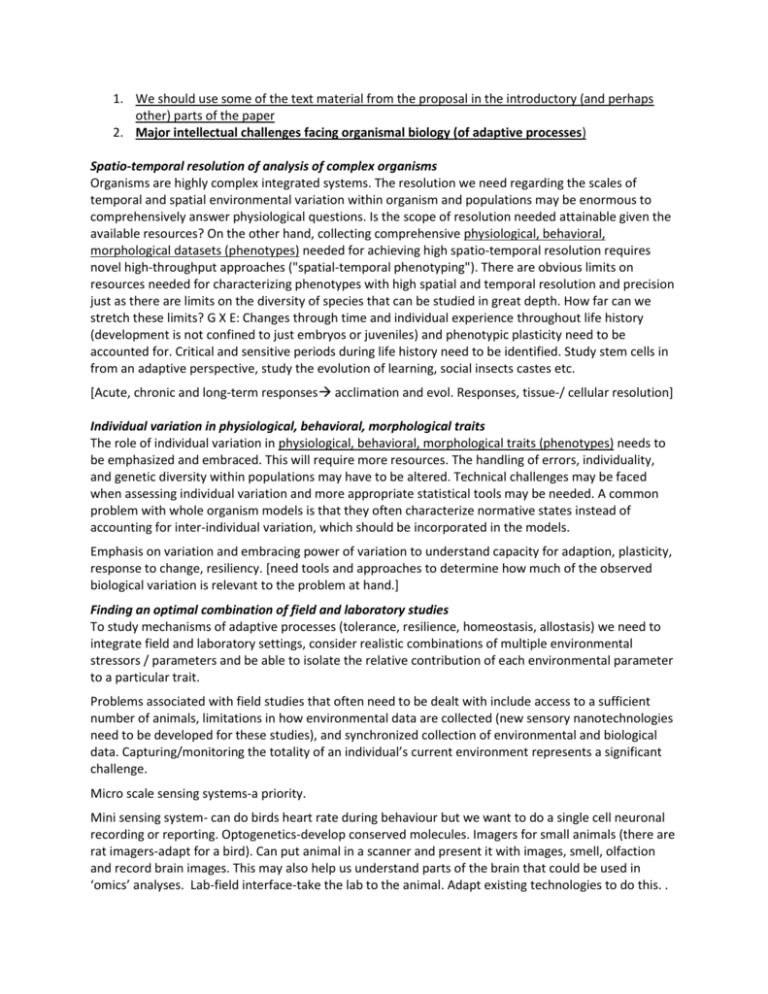
1. We should use some of the text material from the proposal in the introductory (and perhaps other) parts of the paper 2. Major intellectual challenges facing organismal biology (of adaptive processes) Spatio-temporal resolution of analysis of complex organisms Organisms are highly complex integrated systems. The resolution we need regarding the scales of temporal and spatial environmental variation within organism and populations may be enormous to comprehensively answer physiological questions. Is the scope of resolution needed attainable given the available resources? On the other hand, collecting comprehensive physiological, behavioral, morphological datasets (phenotypes) needed for achieving high spatio-temporal resolution requires novel high-throughput approaches ("spatial-temporal phenotyping"). There are obvious limits on resources needed for characterizing phenotypes with high spatial and temporal resolution and precision just as there are limits on the diversity of species that can be studied in great depth. How far can we stretch these limits? G X E: Changes through time and individual experience throughout life history (development is not confined to just embryos or juveniles) and phenotypic plasticity need to be accounted for. Critical and sensitive periods during life history need to be identified. Study stem cells in from an adaptive perspective, study the evolution of learning, social insects castes etc. [Acute, chronic and long-term responses acclimation and evol. Responses, tissue-/ cellular resolution] Individual variation in physiological, behavioral, morphological traits The role of individual variation in physiological, behavioral, morphological traits (phenotypes) needs to be emphasized and embraced. This will require more resources. The handling of errors, individuality, and genetic diversity within populations may have to be altered. Technical challenges may be faced when assessing individual variation and more appropriate statistical tools may be needed. A common problem with whole organism models is that they often characterize normative states instead of accounting for inter-individual variation, which should be incorporated in the models. Emphasis on variation and embracing power of variation to understand capacity for adaption, plasticity, response to change, resiliency. [need tools and approaches to determine how much of the observed biological variation is relevant to the problem at hand.] Finding an optimal combination of field and laboratory studies To study mechanisms of adaptive processes (tolerance, resilience, homeostasis, allostasis) we need to integrate field and laboratory settings, consider realistic combinations of multiple environmental stressors / parameters and be able to isolate the relative contribution of each environmental parameter to a particular trait. Problems associated with field studies that often need to be dealt with include access to a sufficient number of animals, limitations in how environmental data are collected (new sensory nanotechnologies need to be developed for these studies), and synchronized collection of environmental and biological data. Capturing/monitoring the totality of an individual’s current environment represents a significant challenge. Micro scale sensing systems-a priority. Mini sensing system- can do birds heart rate during behaviour but we want to do a single cell neuronal recording or reporting. Optogenetics-develop conserved molecules. Imagers for small animals (there are rat imagers-adapt for a bird). Can put animal in a scanner and present it with images, smell, olfaction and record brain images. This may also help us understand parts of the brain that could be used in ‘omics’ analyses. Lab-field interface-take the lab to the animal. Adapt existing technologies to do this. . Common problems with lab experiments pertain to the representation of meaningful conditions that mimic at least some important aspect of a natural field setting and map reasonably well onto the real world. “Plastic shoebox cages” Let your phenotype lead the way (e.g. a behaviour) Start with different phenotypes (stickleback story, bird courtship displays, foraging types) or use artificial or natural selection experiments to select for particular traits on similar genetic backgrounds. Use candidate gene and candidate pathway approach. Complex phenotypes with multiple traits may mask much of the essence and make it difficult to get to the core of the adaptation. For instance, every gene expression array you harbors information requiring to learn a new aspect of biology. - capacity for largescale, rapid phenotyping of physiological traits and environmental factors is insufficient - Lab and field phenotyping approaches need to be better integrated with fine scale environmental data collection and microsensor development to enable such data collection Start with different phenotypes (stickleback story, bird courtship displays, foraging types) or use artificial or natural selection experiments to generate different groups. Use candidate genes and pathways. Complex phenotypes with multiple traits-how to get to the core of the adaptation. - 5. STRATEGIC CORE ISSUES - "PHENOTYPING" technology - repeated measurements in animals in the natural environements Common model system or unifying theme? Identify a theme. For instance plant people have identified nitrogen fixation as a priority and followed it up with ‘omics etc. Examples for animals: overwintering (hibernation, diapause), migration and navigation, social behaviour, speciation and climate change etc. Recognize power of model systems: interdisciplinary teams should discuss and then choose the best model system (ideally some component field-based) to solve the problem, and that allows use of intellectual, cyber, remote sensing, tacking, engineering and other tools etc. to address the problem under study and that can be used by wider organismal biology community that might not work on the model system. This will allow leverage of the large-scale problem solving approaches for the subset of projects that can be supported in a large scale to indirectly help advance other problems/species. Physiological model systems need to be better enabled Changing the culture of physiology Emerging models for physiology (controversy – do we need to push particular model systems or rather focus on common questions/ themes/ problems): For different physiology processes, environmental drivers? Connections to developmental, morphological models Comparative perspective Leveraging existing models The role of omics for the study of organism x environment interactions High-throughput omics approaches (horizontal platforms) should be applied to (vertical) problems that make sense in the spirit of comparative biology. Conceptually, the many-to-one and one-to-many problem (multiple phenotypes from one genotype; many genes give the same phenotype) needs to be addressed. Network theory needs to be applied to organismal responses, incorporating different actions of conserved networks, and combinatorial design of signaling networks taking into account threshold effects. We must take care that the technology does not drive the research questions but the other way around. Omics approaches focusing on complex organism x environment interactions will be highly interdisciplinary by nature. It may be very difficult to address a problem in this area using omics approaches unless you create a cluster group of individuals, which work together to target a single theme (biological problem/ phenomenon). A cluster group could be comprised of geneticist, physiologist, computational, neuro, behaviour, omics, etc. But the research climate has to support this. Mechanisms for collaboration need to benefit all. New experimental designs are needed to better infer the causality of organismal traits (behavior, physiology). Different types of networks (gene x environment interaction, neural circuits, epigenetics) need to be mapped onto each other. Genomes of more than just one individual are needed for studies of adaptation. Know-how on knock downs, shifting landscapes, machines as models is needed. Computational approach. Huge data sets have been generated but context can be lost-where when and why-shared protocols needed. Recently there is more opportunities for sequencing the genome or transcriptome for a defined problem and the cost is becoming less and less! Sample across space and time. Shared data good for bench marking purposes and sometimes comparison across species can work (foraging flies and bees) but often not. ‘Omics’ analyses are correlational. When do you need to show cause and effect? Depends on the question you are asking. How can causation be demonstrated? • • • • Getting core parties together (Glue grant) – Organismal biologists – Technologists (‘-omics’) – Systems biologists (analysis) Can’t sell a one-behavior paradigm for all species Comparative approach: need many genomes, transcriptomes Complex experimental designs needed – >1 environment – Individual variation – Better statistical tools • Using the environment to interrogate genes and networks Future directions: • Dominance of classical Darwinian evolution • Noninvasive RNA reporting • Optigenomics (brainbow) • Interrogating multiple genes, networks • Synthesizing multiple sensory inputs – (chemical, visual, etc) Using the environment to interrogate genes and networks Future directions: • Dominance of classical Darwinian evolution • Noninvasive RNA reporting • Optigenomics (brainbow) • Interrogating multiple genes, networks A theoretical framework / theory for organismal biology Such a framework is currently missing. Can mathematical models that generate testable hypothesis provide a general framework for organismal adaptation biology? It seems that a unifying (even though simplified) framework would enable community building and more efficient integration of the major elements of O x E interactions (i.e. the environment development, sensory systems, physiology, morphology, behavior fitness evolution). Evolutionary adaptation based on natural selection) is a major driver of evolution (although neutral genetic drift may also play a role) and it is therefore critical to learn how organisms adapt to environmental change, how very complex neural circuits and cellular signaling networks evolve to coordinate organismal responses, and how these networks behave and are modified under intense selection pressure. A theory of organismal scale biology would support a better understanding of organism x environmental processes. One model is hierarchy theory aimed at partitioning out what phenomenon belongs at what level. The objective of such a theory of organismal scale biology would include: - being able to address general (over-arching) questions - combining models that address different specific aspects of those questions - some metric of fitness is always a key - a submodel that relates phenotypes to fitness integrated across the lifecyle - mapping from environment to fitness/phenotype - phenotype as a function of environment - can we fill in the black boxes? Such a theory or model could be used in many disciplines concerned with organismal responses to the environment, for instance: - Development: body size and proportions, interactions in growth,and development of organs at an organismal level. how does it resist and respond to environmental change robustness e.g could connect higher level theories of body size (e.g. termperature-size rule) with development. e.g. common framework for comparative studies. - Eco/Evolutionary physiology: explain degree of covariance between early and adult traits. Bridge the conceptual gap between cell/developmental process and higher levels of organization. An old example of this was the effort to build physiological models of humans. -Behavior Top-down models of learning. Models of how ability to learn is influenced by environment and early experience. Challenges What sources of information do we need – do we need the omics? The model/theory could help identify key pieces of data and provide a framework for data analysis. Data should move beyond omics and include dynamic high level phenotyping. Researchers at working at lower levels of biological organization may not see the utility of the theory. How do you convince reductionist biologists to care about integrative theories? Integrative research is, by its very nature, not cutting edge? – requires disciplinary advances that it can integrate. It is derivative. This is a problem for funding bodies that are concerned only with cutting edge research. Tools for analyzing omics data may be limiting. Solutions A workshop on ‘A theoretical framework for Organismal Biology of Adaptation’ Invite developmental, physiological and behavioral modelers: ‘what is a corresponding useful model in your area of biology’ Identify common themes and approaches. Outcome Development of a framework for generating hypothesis and analyzing and interpreting data from multiple levels of biological organization. A common language for integration. Technical o New ‘omics’ hard to transfer from model to nonmodel Epigenetics o New theory linking evolution and epigenetics needed o Mapping epigenetics to the genome Behavior genes can be complex o Pleiotropic, complex, background effects, sites of action Databasing o Lack of resources for phenotypes o Lack of culture in the community Cyberinfrastructure Community-driven major, important questions in organism X environment interactions whose solution requires interdisciplinary input, and likely development of new intellectual/software/hardware to reach the goal/solve the problem. CyberInfrastructure for organismal biology / physiology needs to be developed Data ‘standards’ or formats for physiological traits that allowcross system comparisons Analysis tools and workflows: customizing existing tools and new development CI collaboration and training Data management systems A related problem concerns divergent terminology (e.g. the use of the term adaptation) and extremely divergent / non-standardized data formats. Publication is no longer adequate/sufficient way to share results supplementary material is non-uniform and not reviewed. How much data is too much data? Just putting out all the raw data may make the problem worse. Bad data can impede progress? How do we integrate across scales of datasets to do model selection, and go beyond model selection. How do we enable innovation in this area; language in systems biology context is limiting. One piece of innovation that infrastructure can: Create a marketplace of ideas through well-defined standards that allow the sharing of alternate algorithms, workflows, etc Some keys to this: Data standards so you can plug in replacements, easy replacement of components, statistics about how these are used. What are the classes of things we have to automate? for instance, in image processing, what is the unused information content in an image? In a sequence image, what base is called might encode most of the useful data. But in a high resolution image of an organ, much untapped information might still be there. Combining organism response with environmental data; need data on both, and need ways to correlate them, infrastructure, and timing NEON hopes to address this problem. 1. Can we frame the specializations of our animals in a common currency or language? - A GOOD POSITIVE EXAMPLE: Circadian biology - eg., "all animals face challenges vs opportunities" - 2. Technology development for phenotyping live animals. - 3. Incorporating variation (including sex/gender) in our thinking - A CLUSTER GRANT that brings in bioinfo, evol, mechansistic biologists... - MULTIDISCIPLINARY TRAINING - students need to be trained in omics - need for statistics - leveraging an appreciation of "variation" - DATA STORAGE -- common platforms for lots of data Phenotype data may be the harder of the 2 kinds to share (vs. genotype) quality is harder to quantify. Infrastructure to share is one (necessary) thing. We can and should continue to invest in repositories. How you use it effectively is harder. Need for better model description and sharing. Need for better analysis/workflow description and sharing. Broader impacts of organismal adaptation biology Consider broader significance of these large-scale interdisciplinary problems that intrinsically focus on basic science of animal/environment issues. These could be impacts of environmental/climate change or disturbance, urbanization, and human societal impacts such as public/global health issues (e.g., vector biology), resource management (e.g. fisheries), conservation, ecosystem services, human-animal interface. Community building Many challenges require many specialists –need cluster groups. Every time you do a gene expression array you have to learn a new field of biology necessaty for collaboration / clusters. Hire at universities this way. Problems should involve inter/multi-disciplinary approach, include relevant fields of organismal biology as well as other disciplines such as engineering, math, ecology/evolution, biochem/molecular/omics, even biomedical community if appropriate to problem. Pursue novel strategies and tool development e.g., sensory systems, remote tracking and data collection, emphasis on non-invasive/field-based studies when possible (can combine lab & field). Use a problem solving approach to insure interdisciplinarity in research approach, tool development, computational/bioinformatics capacity and student training. Genome to organism; genome could be the filing cabinet for information; (no environmental interactions are included). Whole organism data may not linearly build just from genomes (biophysical processes, etc). How do you need to integrate this data, and when do you need to integrate this data? Just gene-by-gene interaction is taking a huge amount of the resources of NIH and still isn't solved (for one organism); gene-by-environment could be much harder. Disconnect but what is being said in terms of what people want, and the interactions across scale that are required. To make reasonable progress, we're going to have to be careful about what to include and what to exclude (because we are a long way from including it all). Network is a real, but hidden, growing, cost. The age of moving datasets to your lab is likely ending. Co-locate computation and data resources so you can do analysis where the data are. How do you support innovation *and* production use. Sustaining investment in software remains a huge issue. NIH has a software maintenance program which is worth looking at. How we will fund application development, and sustaining the software (support, etc). How do we prioritize to know what is worth sustaining? Community building tools Synthesis centers: catalysis meeting RCNs Physiological model systems Data methods and best practices for physiological traits LTORs: long-term organismal research Long-term, place-based Consistent environmental data Science-driven CI development Centers for collaborative research teams Whether innovation comes collectively or from individuals, sharing is critical, because without this, there is no way to build on the work of others. • • Getting core parties together (Glue grant) – Organismal biologists – Technologists (‘-omics’) – Systems biologists (analysis) Can’t sell a one-behavior paradigm for all species 3. Education and Training How do we go about encouraging interdisciplinary views? (see many other reports, such as Bio2010). Can't increase course numbers, but encourage more quantitative stuff throughout existing biology courses. Statistics is going to be more important. Coding is too. Can integrate this in existing courses as well. Needs some repetition throughout the curriculum. At least basics of algorithms. Where to move from basic concepts to building real software? Does the graduate level require a deeper understanding of algorithms and software? How do we get people to understand what their software is actually doing? Is there room at the undergrad level for new majors that marry math, programming, stats with the biology (With interdisciplinary research integrated every year)? TRAINING and COMMUNICATION: - the importance of the comparative approach to explain natural organismal variation - engaging horizontal platform guys with vertical biology (i.e., there's not a single ideal phentoype) • • • • Taxonomic vs. conceptual routes to science A ‘Woods Hole’ course for Ecological Genomics Bridging the computational divide – Mentoring graduate students Choosing a particular system or species for particular questions Teach biology from an organismal perspective. Center on the organism from and function rather than breaking organsism down into levels of organization. Problem, Mismatch between the speed of science and the speed of granting-especially in the speed of advancement in ‘omoics’ and nanotech. Suggestions: SMALL GRANTS Provide a small grant competition to a particular researcher for a specific project of this type, short writeup. Transdisciplinary expertise is required including computational expertise hence CLUSTER GROUP GRANT FUNDING TRAINING: Train a new cohort of individuals in transdisciplinary research. Have dual supervision in different areas of expertise. Project has to be transdisciplinary. Several month placements in different labs. CULTURE CHANGE: Reward for collaboration-federal gov’t Non-tenured professors encouraged to collaborate and be part of a cluster group. Hire people into cluster groups (not Noah’s ark-one of each). Nurture and help people who work at the edges of disciplines. Train in multiple labs/areas need more computation - 2) "rodent-centric" biology (a training and communication challenge) - 2. how to promote awareness and respect for organismal diversity: "Animals Are Cool" - LOSS of ORGANIMSAL in Intor Biology - "ANIMALS ARE COOL"
